Messenger Kids adds expanded parental controls, details how much kids’ data Facebook collects
Facebook’s messaging app for families with children, Messenger Kids, is being updated today with new tools and features to give parents more oversight and control over their kids’ chats. Now, parents will be able to see who a child is chatting with and how often, view recent photos and videos sent through chat, access the child’s reported and block list, remotely log out of the app on other devices and download the child’s chats, images and videos, both sent and received. The company is also introducing a new blocking mechanism and has updated the app’s Privacy Policy to include additional information about data collection, use and deletion practices.
The Messenger Kids app was first introduced in late 2017 as a way to give kids a way to message friends and family with parental oversight. It arrived at a time when kids were already embracing messaging — but were often doing so on less controlled platforms, like Kik, which attracted predators. Messenger Kids instead allows the child’s parents to determine who the child can chat with and when, through built-in parental controls.
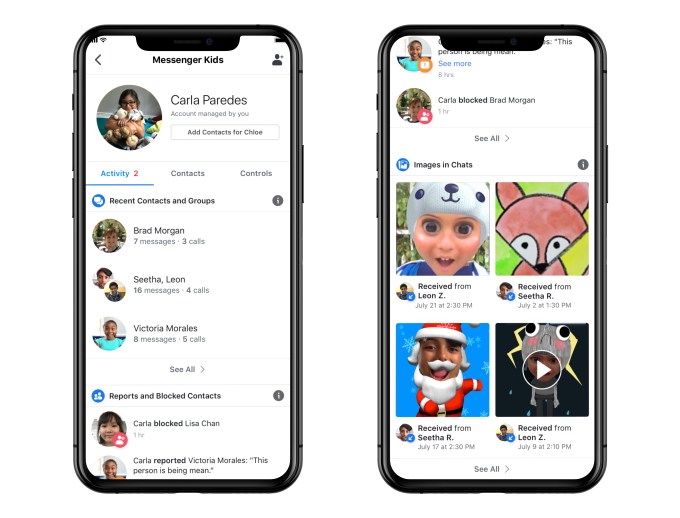
In our household, for example, it became a convenient tool for chatting with relatives, like grandparents, aunts, uncles and cousins, as well as a few trusted friends, whose parents I knew well.
But when it came time to review the chats, a lot of scrolling back was involved.
The new Messenger Kids features will help with the oversight aspects for those parents who allow their kids to online chat. That decision, of course, is a personal one. Some parents don’t want their kids to have smartphones and outright ban apps, particularly ones that allow interactions. Others, myself included, believe that teaching kids to navigate the online world is part of your parental responsibility. And despite Facebook’s reputation, there aren’t other chat apps offering these sort of parental controls — or the convenience of being able to add everyone in your family to a child’s chat list with ease. (After all, grandma and grandpa are already on Facebook and Messenger, but getting them to download new apps remains difficult.)
In the updated app, parents will be able to see who a child has been chatting with, and whether that’s text or video chat, over the past 30 days. This can save parents’ time, as they may not feel the need to review chat with trusted family members, for instance, so can redirect their focus and energy on reviewing the chats with friends. A log of images will help parents to see if all images and videos being sent and received are appropriate, and remove them or block them if not.

Parents also can now see if a child has blocked or reported a user in the app, or if they’ve unblocked them. This could be useful for identifying those problematic friends — the kind who sometimes cause trouble, but are later forgiven, then unblocked. (Anyone who’s dealt with tween-age drama can attest to the fact that there’s one in every group!) By gaining access to this information, parents can sit down with the child to talk about when to take that step and block someone, and when a disagreement with a friend can instead be worked out. These are decisions that a child will have to make on their own one day, so being able to use this as a teaching moment is useful.
With the update, unblocking is supported and parents are still able to review chats with blocked contacts. However, blocked contacts will remain visible to one another and will stay in shared group chats. They just aren’t able to message one-on-one. Kids are warned if they return to or are added to chats with blocked contacts. (If parents want a full block, they can just remove the blocked contact from the child’s contact list, as before.)

Remote device logout lets you make sure the child is logged out of Messenger Kids on devices you can’t physically access and control — like a misplaced phone. And the option to download the child’s information, similar to Facebook’s feature, lets you download a copy of everything — messages, images and videos. This could be a way to preserve their chat history when the child outgrows the app.

The Messenger Kids’ privacy policy was updated, as well, to better detail the information being collected. The app also attempts to explain this in plain language to the kids, using cute photos. In reality, parents should read the policy for themselves and make a decision, accordingly.
The app collects a lot of information — including names, profile photos, demographic details (gender and birthday), a child’s connection to parents, contacts’ information (like most frequent contacts), app usage information, device attributes and unique identifiers, data from device settings (like time zones or access to camera and photos), network information and information provided from things like bug reports or feedback/contact forms.
To some extent, this information is needed to help the app properly operate or to alert parents about a child’s activities. But the policy includes less transparent language about the collected information being used to “evaluate, troubleshoot, improve, create, and develop our products” or being shared with other Facebook Companies. There’s a lot of wiggle room there for extensive data collection on Facebook’s part. Service providers offering technical infrastructure and support, like a content delivery network or customer service, may also gain access to collected information, but must adhere to “strict data confidentiality and security obligations,” the policy claims, without offering further details on what those are.

Despite its lengthiness, the policy leaves plenty of room for Facebook to collect private information and share it. If you have a Facebook account, you’ve already agreed to this sort of “deal with the devil” for yourself, in order to benefit from Facebook’s free service. But parents need to strongly consider if they’re comfortable making the same decision for their children.
The policy also describes things Facebook plans to roll out later, when Messenger Kids is updated to support older kids. As kids enter tween to teen years, parents may want to loosen the reigns a bit. The new policy will cover those changes, as well.
It’s unfortunate that the easiest tool, and the one with the best parental controls, is coming from Facebook. The market is ripe for a disruptor in the kids’ space, but there’s not enough money in that, apparently. Facebook, of course, sees the potential of getting kids hooked early and can invest in a product that isn’t directly monetized. Few companies can afford to do this, but Apple would be the best to take Facebook on in this area.
Apple’s iMessage is a large, secure and private platform — but it lacks these advanced parental controls, as well as the other bells and whistles (like built-in AR filters) that make the Messenger Kids app fun. Critically, it doesn’t work across non-Apple devices, which will always be a limiter when it comes to finding an app that the extended family can use together.
To be clear, there is no way to stop Facebook from vacuuming up the child’s information except to delete the child’s Messenger Kids Account through the Facebook Help Center. So consider your choices wisely.
Powered by WPeMatico
The Meta, a training platform for gamers, builds on Kovaak’s FPS Aim Trainer
As esports grows and creates opportunities for gamers to level up to the pro or streamer level, there is still a huge barrier in the way. There is not a wealth of training options for gamers. If you can’t get better within the environment of the game itself, then you’ve peaked. Practice makes perfect, but what if there’s no such thing as practice?
The Meta is looking to change that with the launch of a new training platform that builds off the success of Kovaak’s FPS Aim Trainer. Kovaak is a former Quake pro, known for his hyper-accurate aim, who built Kovaak’s FPS Aim Trainer out of personal need. He wanted a way to grind out his mechanical aiming skills, and built out various scenarios across 10+ major titles to practice.
The Meta co-founders Duncan Haberly, Jay Brown, and Chris Olson had been working on their own training platform that focuses on guided trainings around specific skills, with physics and gun mechanics identical to popular titles, to let gamers learn from their mistakes and train better habits.
After the two esports entrepreneurial teams met, they decided to join forces and offer what they believe to be the ultimate training tool.
It’s comprised of two parts. The first is The Meta’s self-guided training platform, with various branches that focus on a different skill set in FPS gaming. The second is Kovaak’s Sandbox, the aim trainer that lets users test the skills they’ve learned by playing through more than 2,600 user-generated scenarios.
For now, The Meta-guided training focuses on flicking (otherwise known as click timing), with plans to introduce tracking and scoping skill branches soon. The self-guided training side of the platform feeds users insights about their deficiencies — maybe they tend to miss their shots when enemies are in the upper-left quadrant of the screen — so they can dedicate time and energy to improving that part of their game in the aim trainer.
The Meta is available on Steam for PC players, with plans to launch for consoles in the future.
The flicking trainer has more than 40 sub-levels, with support for Overwatch and Fortnite. Kovaak’s Sandbox, as the FPS Aim Trainer is now known, has more than 2,600 user-created scenarios, and supports titles like Overwatch, Fortnite, Quake, Call of Duty, Apex Legends, Paladins, CS:GO, Battlefield and Rainbow 6.
The Meta is $9.99 as a single-time payment, and the company says it’s currently averaging 20,000 units sold per month. The gaming startup has raised $2.5 million in funding from investors like Village Global, Canaan Beta Fund, Courtside VC, AET Fund (Akatsuki Entertainment Technology), betaworks and GFR Fund (GREE).
There is movement in the esports space around training and improvement. In 2018, Epic Games introduced Playground Mode to allow players a chance to experience the Fortnite environment without dropping in alongside 99 other gamers. PlayVS, the startup looking to take the esports infrastructure to the high school and college level, is investing heavily in data, reporting stats and analysis to players, coaches, fans and recruiters. StateSpace, a direct competitor to The Meta with $4 million in funding, uses neuroscience to help gamers train, hoping to create a standardized metric by which gamers’ skills can be measured.
Esports is growing across almost every metric, from viewership to awareness to revenue, and with that, we can only expect to see more startups dive into the space and stake their claim.
Powered by WPeMatico
Emerge raises $20M to take its digital freight marketplace for truckers up a gear
Trucking is currently the most popular mode of transporting freight in the U.S., accounting for around $12.5 billion of the $17 billion freight market, according to the Bureau of Transportation Statistics. But with thousands of small and single-vehicle operators and legacy (often paper-based) systems underpinning communications, it’s also one of the most inefficient.
Now there are signs that this is changing. A startup out of Phoenix, Ariz. called Emerge, which has built a platform for shippers and brokers to find and allocate truck freight more effectively across the long tail of available truck-based carriers (a little like a Flexport but for trucks), is announcing a round of $20 million, funding it will use to continue building out its technology, as well as to keep expanding business.
The Series A — led by NewRoad Capital Partners, with previous investors Greycroft and 9Yards Capital also participating — comes on the heels of some already strong traction for Emerge. Since being founded in 2018 by brothers Andrew and Michael Leto, the company has processed more than $1 billion in freight with 1,500% year-over-year growth between 2018 and 2019. Emerge has now raised just over $40 million and we understand that its valuation is currently at more than $100 million.
Some of its traction so far is down to the founders. Both are vets of the trucking industry whose previous company, a multimodal shipment visibility/supply chain solutions platform called 10-4, sold to Trimble in a $400 million deal. And some of that is down to the gap in the market that Emerge is filling.
“Gap” is actually the operative word here. How shipments are booked on trucks today is quite inefficient, with orders often leaving empty spaces on truck beds that could be filled with goods going in the same direction; and in about 20% of all journeys carrying no load at all.
Part of the reason for this is the antiquated way that shippers book space on trucks, and part of the reason is because there is just simply too much fragmentation in the system, with 80% of all shipments today contract-based and the remaining 20% operating as a “spot market” and booked on the fly, and neither of them particularly efficient when it comes to truck occupancy. (Most of the latter spot market is booked through spreadsheets and email, Michael Leto, the CEO, said in an interview.)
Emerge’s solution is something of a stick-and-carrot approach that reminds me a little also of how advertising exchanges work.
A shipper that wants to use the Emerge platform essentially activates/lists its entire inventory of truck providers on the platform to get started. That list and inventory, in turn, become part of a bigger database of other providers: and again, this is a long-tail approach, with typically the trucking companies on the platform having no more than 200 trucks (and often fewer) in their fleets.
Then, when a shipper goes to Emerge to book a shipment, options are provided that might include previous truckers, but might also include others. The idea is that this provides a more efficient picture, and that in turn gets passed on as cost savings to the customers, who can typically reduce shipping costs by as much as 20% using the platform.
If the cost savings and expanded choice are the carrots, the stick comes in the form of the requirement to upload truck data and share it with other shippers: you can’t use the system without doing it.
“But it’s a network effect,” Leto explained when I asked if Emerge ever saw resistance to the model. “We allow these companies to share capacity to drive efficiencies, and to drive and lower costs with less deadhead miles. There are a lot of benefits to capacity sharing.” It doesn’t seem to have deterred too many in any case. There are currently some 30,000 carrier profiles on the platform, and 12,000 transportation entities — including carriers, brokers or other shippers — transacted in Q4 alone, speaking to activity on the platform being strong.
Emerge is not the only company that has identified the opportunity in providing a better and more updated platform to communicate and book space in the fragmented truck market. Sennder out of Berlin — which last year raised a sizeable round of funding — has also built a platform to centralise communications around booking shipments. It, however, seems to have less of an emphasis on encouraging shippers to take the lead in expanding that network effect that Leto describes.
Others that are tackling the wider shipping and logistics market and trying to improve how it runs include Sendy out of Kenya, which recently also announced a $20 million raise; Flexport, which now has a $3.2 billion valuation; Zencargo, which has also raised $20 million; and FreightHub ($30 million), Bringg ($25 million) and NEXT ($97 million).
But within that, Emerge’s performance so far, coupled with the Leto brothers’ history as founders, is giving the startup some extra mileage as we enter the next phase of what trucking might hold, which could include a critical mass of autonomous and electric vehicles on pre-defined routes.
“Uniquely, Emerge combines an exciting new technology designed to serve existing, unmet market need with experienced industry operators and entrepreneurs,” said Tracy Black of NewRoad in a statement. “Andrew and Michael are building the most innovative marketplace we’ve seen in the freight and digital marketplace industry — bringing contracts and carriers together to create new capacity. We are excited to be leading their Series A and I am thrilled to join the board to support their growth.”
Powered by WPeMatico
Neo4j 4.0 graph database platform brings unlimited scaling
Neo4j, the premiere graph database development platform, announced the release of version 4.0 today, which features unlimited scaling among other updates.
Graph databases are growing increasingly important as they are used to find connections in data, such as if you bought this, you might like this related item on an e-commerce site; or if you have these friends, you might also know these people on a social site. It’s growing popular in business, and especially among data scientists, who find it useful to find relationships in large collections of data.
Neo4j founder and CEO Emil Eifrem says the company developed the graph database concept, and it has been growing and developing well. “2019 was a really good year for us, generally speaking, but I think more importantly in the graph space. We’ve chosen the category creation and go- to-market strategy when we put the word graph and database together, and we wanted to evangelize that as a concept,” he explained.
As for the new version, Eifrem says it’s a broad new release, but there are a few things he wanted to focus on. For starters is the ability to limitlessly scale. He says this is possible because of new sophisticated horizontal scaling in version 4.0. For previous versions, the company replicated data across the database, a common method for processing data, but it can slow down as the amount of data scales. They wanted to change this in the new version.
“What we’re adding now in 4.0 is partitioning. So this is what’s called ‘sharding’ in the database world. It’s this really ultra powerful feature that allows you to scale both reads and writes and size. Basically, you’re only limited by your budget, how many machines you can add,” he explained.
Another piece in the new release is the addition of role-based access. As graph databases spread from the department or team level across the organization, it becomes increasingly important to restrict certain data to only those who have access based on their role and privileges.
“Today, graph databases in Neo4j are being widely deployed across the enterprise, and now all of a sudden there’s multiple teams across the entire enterprise that wants to access the data. And then you get into security and privacy concerns,” he said. That’s where role based access can protect the data.
The new version has many other features including the ability to run multiple databases on a single Neo4j cluster and support for “Reactive” systems, which gives these kinds of developers “full control over how their applications interact with the database, including robust data pipelines, streaming data, machine learning and more,” according to the company.
Neo4j has been around 2007 and has raised over $160 million, according to Crunchbase.
Powered by WPeMatico
Monday.com 2.0 workflow platform lets companies build custom apps
Monday.com, announced version 2.0 of its flexible workflow platform today, making it easier for customers to build custom apps on top of Monday.
Company co-founder and CEO Roy Mann says his product is a multi-purpose and highly flexible workflow tool, aimed mostly at medium-sized businesses. “It’s process management, portfolio management, project management, CRM management, hotel management, R&D management. It’s anything you want because we give you the building blocks to build whatever you want,” he said.
With the release of 2.0, the company is offering a code-free environment to take these building blocks and build custom applications to meet the needs of any organization or team. This can include workflow elements to set up a process inside Monday or integrate with other apps or services.
In fact, the new release includes over a hundred prebuilt automation recipes and code-free custom-automations along with more than 50 integrations with other apps, allowing project managers to build fairly sophisticated workflows without coding.
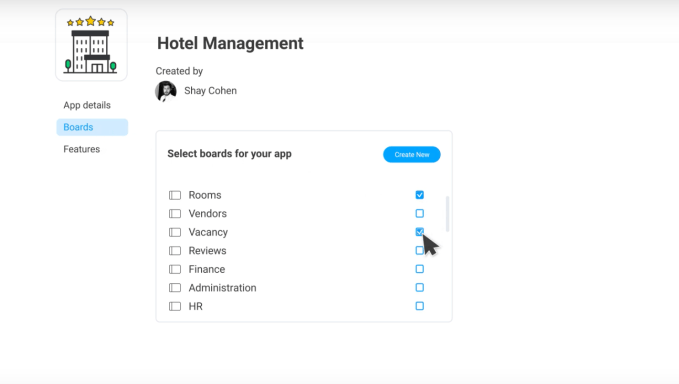
This example shows a company building a custom app to manage a hotel. Screenshot: Monday.com
The company is also opening up the Monday platform to developers who want to build applications on top of the platform. Mann says this is just the start, and the plan is to eventually add a marketplace for these apps.
“The first step will be we’re opening [the platform to developers] up in beta. [Initially], it will be for their own use and for their customers, and then we will open it up pretty soon for them to offer those apps [in a marketplace]. That’s obviously the direction,” Mann said.
With $120 million in ARR and 100,000 customers, the company has quietly gone about its business. It has 370 employees, mostly based in Israel, and has raised $273 million, according to Mann. Its most recent investment came last July — $150 million on a lofty $1.9 billion valuation.
Powered by WPeMatico
Nomagic, a startup out of Poland, picks up $8.6M for its pick-and-place warehouse robots
Factories and warehouses have been two of the biggest markets for robots in the last several years, with machines taking on mundane, if limited, processes to speed up work and free up humans to do other, more complex tasks. Now, a startup out of Poland that is widening the scope of what those robots can do is announcing funding, a sign not just of how robotic technology has been evolving, but of the growing demand for more automation, specifically in the world of logistics and fulfilment.
Nomagic, which has developed way for a robotic arm to identify an item from an unordered selection, pick it up and then pack it into a box, is today announcing that it has raised $8.6 million in funding, one of the largest-ever seed rounds for a Polish startup. Co-led by Khosla Ventures and Hoxton Ventures, the round also included participation from DN Capital, Capnamic Ventures and Manta Ray, all previous backers of Nomagic.
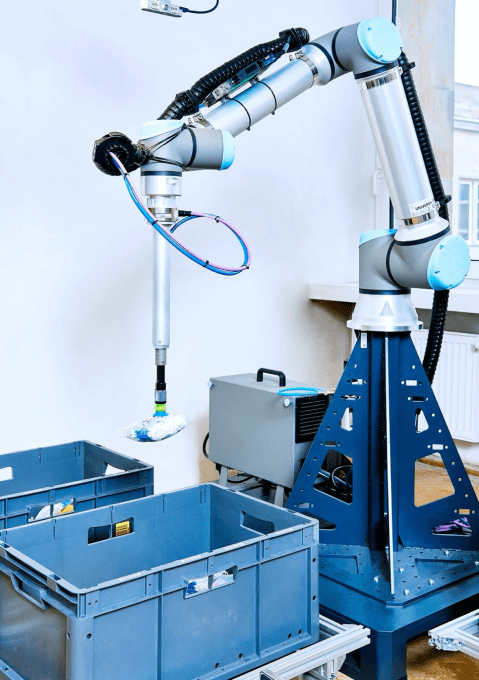 There are a number of robotic arms on the market today that can be programmed to pick up and deposit items from Point A to Point B. But we are only starting to see a new wave of companies focus on bringing these to fulfilment environments because of the limitations of those arms: they can only work when the items are already “ordered” in a predictable way, such as on an assembly line, which has mean that fulfilment of, for example, online orders is usually carried out by humans.
There are a number of robotic arms on the market today that can be programmed to pick up and deposit items from Point A to Point B. But we are only starting to see a new wave of companies focus on bringing these to fulfilment environments because of the limitations of those arms: they can only work when the items are already “ordered” in a predictable way, such as on an assembly line, which has mean that fulfilment of, for example, online orders is usually carried out by humans.
Nomagic has incorporated a new degree of computer vision, machine learning and other AI-based technologies to elevate the capabilities of those robotic arm. Robots powered by its tech can successfully select items from an “unstructured” group of objects — that is, not an assembly line, but potentially another box — before picking it up and placing it elsewhere.
Kacper Nowicki, the ex-Googler CEO of Nomagic who co-founded the company with Marek Cygan (an academic) and Tristan d’Orgeval (formerly of Climate Corporation), noted that while there has been some work on the problem of unstructured objects and industrial robots — in the US, there are some live implementations taking shape, with one, Covariant, recently exiting stealth mode — it has been mostly a “missing piece” in terms of the innovation that has been done to make logistics and fulfilment more efficient.
That is to say, there has been little in the way of bigger commercial roll outs of the technology, creating an opportunity in what is a huge market: fulfilment services are projected to be a $56 billion market by 2021 (currently the US is the biggest single region, estimated at between $13.5 billion and $15.5 billion).
“If every product were a tablet or phone, you could automate a regular robotic arm to pick and pack,” Nowicki said. “But if you have something else, say something in plastic, or a really huge diversity of products, then that is where the problems come in.”
Nowicki was a longtime Googler who moved from Silicon Valley back to Poland to build the company’s first engineering team in the country. In his years at Google, Nowicki worked in areas including Google Cloud and search, but also saw the AI developments underway at Google’s DeepMind subsidiary, and decided he wanted to tackle a new problem for his next challenge.
His interest underscores what has been something of a fork in artificial intelligence in recent years. While some of the earliest implementations of the principles of AI were indeed on robots, these days a lot of robotic hardware seems clunky and even outmoded, while much more of the focus of AI has shifted to software and “non-physical” systems aimed at replicating and improving upon human thought. Even the word “robot” is now just as likely to be seen in the phrase “robotic process automation”, which in fact has nothing to do with physical robots, but software.
“A lot of AI applications are not that appealing,” Nowicki simply noted (indeed, while Nowicki didn’t spell it out, DeepMind in particular has faced a lot of controversy over its own work in areas like healthcare). “But improvements in existing robotics systems by applying machine learning and computer vision so that they can operate in unstructured environments caught my attention. There has been so little automation actually in physical systems, and I believe it’s a place where we still will see a lot of change.”
Interestingly, while the company is focusing on hardware, it’s not actually building hardware per se, but is working on software that can run on the most popular robotic arms in the market today to make them “smarter”.
“We believe that most of the intellectual property in in AI is in the software stack, not the hardware,” said Orgeval. “We look at it as a mechatronics problem, but even there, we believe that this is mainly a software problem.”
Having Khosla as a backer is notable given that a very large part of the VC’s prolific investing has been in North America up to now. Nowicki said he had a connection to the firm by way of his time in the Bay Area, where before Google, Vinod Khosla backed a startup of his (which went bust in one of the dot-com downturns).
While there is an opportunity for Nomagic to take its idea global, for now Khosla’s interested because of the a closer opportunity at home, where Nomagic is already working with third-party logistics and fulfilment providers, as well as retailers like Cdiscount, a French Amazon-style, soup-to-nuts online marketplace.
“The Nomagic team has made significant strides since its founding in 2017,” says Sven Strohband, Managing Director of Khosla Ventures, in a statement. “There’s a massive opportunity within the European market for warehouse robotics and automation, and NoMagic is well-positioned to capture some of that market share.”
Powered by WPeMatico
AI startup Cresta launches from stealth with millions from Greylock and a16z
As Silicon Valley’s entrepreneurs cluster around the worldview that artificial intelligence is poised to change how we work, investors are deciding which use cases make the most sense to pump money into right now. One focus has been the relentless communication between companies and customers that takes place at call centers.
Call center tech has spawned dozens if not hundreds of AI startups, many of which have focused on automating services and using robotic voices to point customers somewhere they can spend money. There has been a lot of progress, but not all of those products have delivered. Cresta is more focused on using AI suggestions to help human contact center workers make the most of an individual call or chat session and lean on what’s worked well for past interactions that were deemed successful.
“I think that there will always be very basic boring stuff that can be automated like frequently asked questions and ‘Oh, what’s the status of my order?,’ ” CEO Zayd Enam says. “But there’s always the role of the person that’s building the relationship between the company and the customer, and that’s a really strategic role for companies in the modern age.”
Udacity co-founder Sebastian Thrun is the startup’s board chairman and is listed as a co-founder. Enam met Thrun during his PhD research at Stanford focused on workplace productivity. Cresta is launching from stealth and announcing that they’ve raised $21 million in funding from investors including Greylock Partners and Andreessen Horowitz. The company recently closed a $15 million Series A round.
Cresta wants to use AI to school customer service workers and salespeople on how to close the deal.
There’s quite a lot of turnover in contact center jobs and that can leave companies reticent to spend a ton of time investing in each employee’s training. Naturally, there are some inherent issues where the workers interacting with an individual customer might not have the experience necessary to suggest a solution that they might if they had more experience. In terms of live feedback, for many, fumbling through paper scripts at their desk can be about as good as it gets. Cresta is hoping that by tapping improvements in natural language processing, their software can help alleviate some stress for contact center workers and help them move conversations in the direction of selling something else for their company.
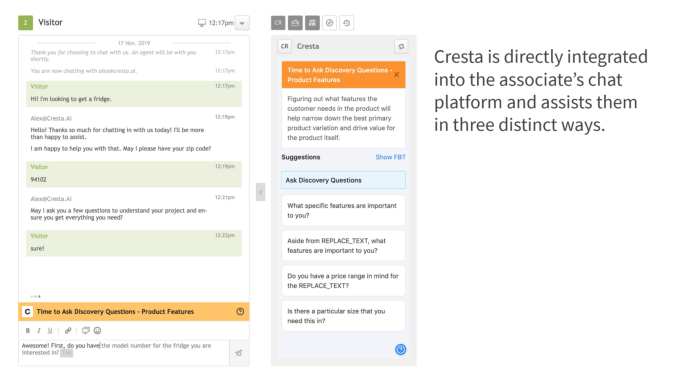
Cresta is entering a field where there’s already quite a bit of interest from established software giants. Salesforce, Google and Twilio all operate AI-driven products for contact centers. Even with substantial competition, Enam believes Cresta’s team of 30 can offer its customers a lot more individual attention.
“We’re one of the few technical teams where we’re just obsessed with the customer, to the point where it’s normal for people on our team to fly to the customer and live by a call center in an Airbnb for a week,” Enam said. “When Greylock led the Series A, they had heard that and said that’s what gave them so much conviction that we were the team to solve the problem.”
Sun Microsystems co-founder Andy Bechtolsheim, Mark Leslie and Vivi Nevo are also investors in Cresta.
Powered by WPeMatico
HPE acquires cloud native security startup Scytale
HPE announced today that it has acquired Scytale, a cloud native security startup that is built on the open-source Secure Production Identity Framework for Everyone (SPIFFE) protocol. The companies did not share the acquisition price.
Specifically, Scytale looks at application-to-application identity and access management, something that is increasingly important as more transactions take place between applications without any human intervention. It’s imperative that the application knows it’s OK to share information with the other application.
This is an area that HPE wants to expand into, Dave Husak, HPE fellow and GM of cloudless initiative wrote in a blog post announcing the acquisition. “As HPE progresses into this next chapter, delivering on our differentiated, edge to cloud platform as-a-service strategy, security will continue to play a fundamental role. We recognize that every organization that operates in a hybrid, multi-cloud environment requires 100% secure, zero trust systems, that can dynamically identify and authenticate data and applications in real-time,” Husak wrote.
He also was careful to stress that HPE would continue to be good stewards of the SPIFFE and SPIRE (the SPIFFE Runtime Environment) projects, both of which are under the auspices of the Cloud Native Computing Foundation.
Scytale co-founder Sunil James, writing in a blog post about the deal, indicated that this was important to the founders that HPE respect the startup’s open-source roots. “Scytale’s DNA is security, distributed systems, and open-source. Under HPE, Scytale will continue to help steward SPIFFE. Our ever-growing and vocal community will lead us. We’ll toil to maintain this transparent and vendor-neutral project, which will be fundamental in HPE’s plans to deliver a dynamic, open, and secure edge-to-cloud platform,” he wrote.
Scytale was founded in 2017 and had raised $8 million, according to PitchBook data. The bulk of that was in a $5 million Series A last March led by Bessemer. The deal closed today.
Powered by WPeMatico
MIT’s RFocus technology could turn your walls into antennas
RFocus asks a simple question: What if instead of just antennas and transmitters on access points and mobile devices, we put the things just about everywhere? You know, just totally slather the walls with the stuff? The new “smart surface” from MIT’s CSAIL uses in excess of 3,000 antennas to boost signal strength by nearly 10x.
The department issued a paper today showcasing the technology, which is relatively cheap, with each antenna running a few cents. Better still, it’s low power, either reflecting a signal or allowing it through, depending on the software controller. CSAIL envisions a future where RFocus is used in homes and warehouses to boost signals for the Internet of Things and various network-connected devices.
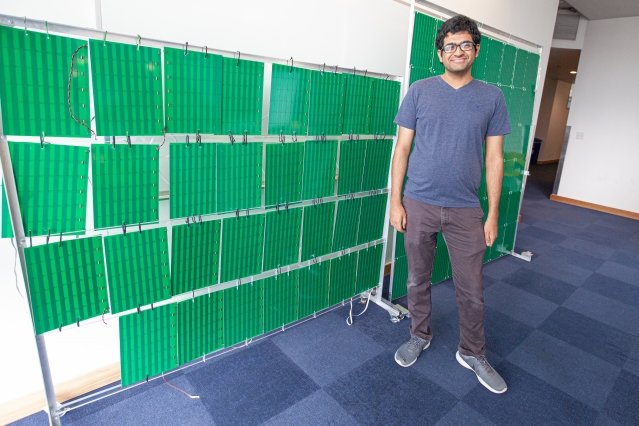
“The core goal here was to explore whether we can use elements in the environment and arrange them to direct the signal in a way that we can actually control,” MIT professor Hari Balakrishnan said in a post detailing the technology. “If you want to have wireless devices that transmit at the lowest possible power, but give you a good signal, this seems to be one extremely promising way to do it.”
No word on a time frame to market here — that’s not really how CSAIL operates. The team also notes that similar research has been conducted by Princeton, though MIT’s focus is on low-cost and a wider range of applications. The notion of full-wall antennas certainly seems a bit far-fetched — and in most cases unnecessary. And given the sort of caution with which many have approached 5G, I suspect more research will have to be done on the long-term effects of such transitions.
Powered by WPeMatico
Microsoft Teams has been down this morning
Microsoft Teams, the collaboration platform that competes with Slack, has been down since about 8:30 am ET. Microsoft reports the outage was due to an expired certificate.
Microsoft first posted on its Office 365 Status Twitter feed about 9:00 am ET that an outage was in progress, stating the company was looking into the problem.
We’re investigating an issue where users may be unable to access Microsoft Teams. We’re reviewing systems data to determine the cause of the issue. More information can be found in the Admin center under TM202916
— Microsoft 365 Status (@MSFT365Status) February 3, 2020
At approximately 10:00 am ET, the company posted the reason for the problem, an expired certificate, which frankly, has to be pretty embarrassing for the group responsible for keeping the Teams service running.
We’ve determined that an authentication certificate has expired causing, users to have issues using the service. We’re developing a fix to apply a new certificate to the service which will remediate impact. Further updates can be found under TM202916 in the admin center.
— Microsoft 365 Status (@MSFT365Status) February 3, 2020
About an hour ago, the company updated the status again, indicating it had begun deploying the updated certificate.
We’ve initiated the deployment of the updated certificate and are monitoring service health as the fix progresses. Additional information can be found under TM202916 in the admin center.
— Microsoft 365 Status (@MSFT365Status) February 3, 2020
Some customers have begun reporting on Twitter that service has been restored.
Microsoft has kept the status updates pretty business like, but has not apologized to its 20 million users as of publication. The company is in the midst of a battle with Slack for hearts and minds in the enterprise collaboration space, and a preventable outage has to be awkward for them.
The company will no doubt do a post-mortem to figure out how this mistake happened and how to prevent this kind of issue from taking down the site again. While every service is going to experience an outage from time to time, it’s up to the organization to understand why it happened and put systems in place to keep a preventable incident like this one from happening again in the future.
Powered by WPeMatico
